New Zealand’s short-tailed bats are tiny – but their appetite is massive. They can increase their bodyweight by a huge 30% in just one night’s successful foraging. That’s some serious pigging out!
So just how tiny are they? Well, head to tail their body length is only 6-7cm, but across-wise, short-tailed bats have a 28-30cm wingspan and (before heading out to feed), adults weigh 10-22 grams. As their name suggests, their tail is indeed short – a mere 12mm long.
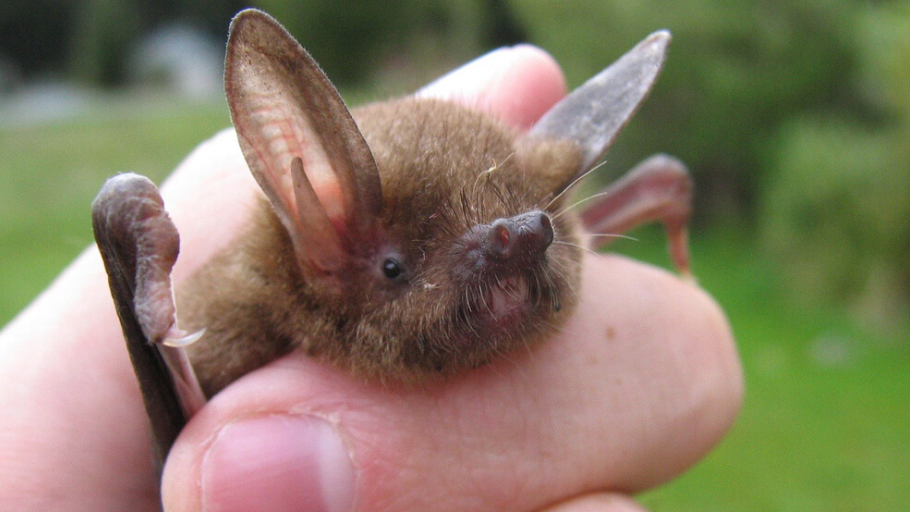
Known as pekapeka-tou-poto in Māori (and Mystacina tuberculata in Latin), the lesser short-tailed bat is the only living species of bat in the family Mystacinidae and is endemic to New Zealand. There used to be a greater short-tailed bat too. It was found on two islands off Stewart Island but following an invasion of ship rats, it was last sighted in 1967 and is probably extinct.
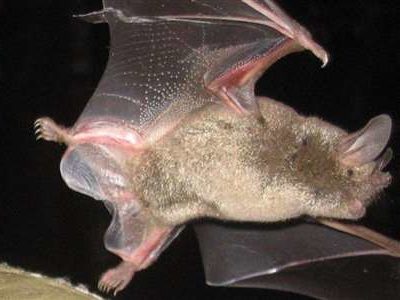
The ‘lesser’ is declining in numbers too, for all the usual reasons: forest clearance and introduced predators and that’s a real tragedy, because they’re fascinating little creatures. Bats generally, are strange – furry mammals with wings – but our little pekapeka has got to be one of the weirdest of the weird.
For a start, its one of the most terrestrial of bats and forages on the forest floor far more than any other bat species, running around on in the leaf litter in search of tasty morsels. Short-tailed bats eat insects, especially beetles, flies, and moths, as well as flowers, fruit, nectar, and pollen.
Pekapeka-tou-poto has relatively large, pointed ears and a long, conical snout with numerous whiskers, ending in large, tubular nostrils. The tongue is long and slender (about 12 mm in length) and has a number of hair-like structures at the tip, that aid in feeding on nectar – a bit like the tongue of one of our other endemic nectar feeders – the tūī.
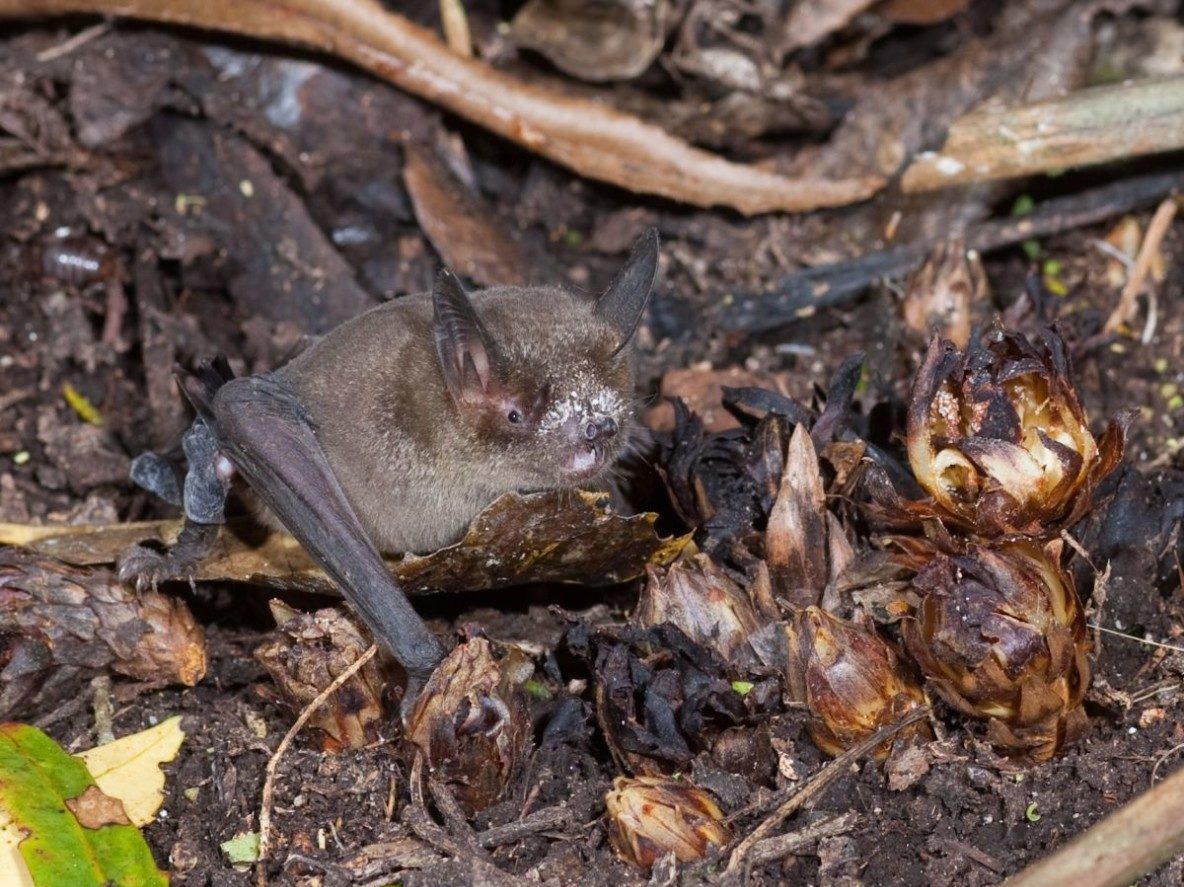
Another unique distinguishing feature is the presence of small talons at the base of the main claws on both its toes and wings. The tiny talons probably help with both crawling and climbing. The bat has very thick fur, which varies from dark brown to mousy-grey, and is slightly paler on the underside of the animal.
But perhaps the strangest thing of all about the Aotearoa’s short-tailed bat is the unique relationship it has with another bizarre organism the wood rose.
The wood rose is neither wooden nor a rose. Dactylanthus taylorii is a fully parasitic flowering plant, the only one endemic to New Zealand. The host tree responds to the presence of Dactylanthus by forming a burl-like structure that looks like the fluted petals of a wooden rose. It can grow to the size of a basketball.
When the flowers emerge on the forest floor, they are pollinated by the ground-foraging short-tailed bat. Fossil evidence suggests that kakapo once pollinated the wood rose too, but in modern times, this uniquely New Zealand plant is totally dependent for its reproduction on our equally rare and unique bat.
Dactylanthus taylorii is also dependent on its host plant for its day-to-day survival. It has a round warty tuber-like stem (up to 50 cm wide) or haustorium with no roots, which draws nutrients from the roots of its host. Its leaves don’t photosynthesise and are reduced to floral bracts.
So the ‘wood rose’ is actually the attachment point between tuber and host. The host’s roots expand to form a fluted disk, resembling a flower. This growth was once dug up in the thousands, incidentally killing the Dactylanthus, and sold as a collectable curio.
The wood rose prefers damp but not waterlogged soil and is often found at the head of small streams. About 30 species of native hardwood trees and shrubs make suitable hosts, but it prefers those growing in secondary forest on the margin of mature podocarp forest. Common hosts include pate or seven-finger (Schefflera digitata), five-finger (Pseudopanax arboreus), lemonwood (Pittosporum eugenioides), and putaputaweta (Carpodetus serratus).
Wood rose plants are either male or female. They flower between February and May. A single tuber, with about 40 inflorescences, will produce half to a full cup of nectar over its 10-day flowering period.
The nectar contains a mammalian pheromone, squalene, which explains why it is so attractive not only to the bat but to species such as the brush-tailed possum. The nectar exudes a musky smell that resembles mammalian sweat. Introduced mice and rats also pollinate the wood rose, although rats tend to destroy them. Once pollinated, the wood rose produces fruits slightly under 2 mm long.
The plant begins life as tiny seed, one of thousands produced by a single inflorescence. That seed germinates and waits for the root of a preferred host tree to grow past it. If that happens the seed’s radicle establishes an intimate relationship with the root, but doesn’t actually penetrate it. In response, the root develops a flared surface that the tuber fits around, like a bottle-top fitting around a bottle. It is the distinctive shape of the roots that are the wood roses.
Dactylanthus is currently found only in the North Island, but fossil pollen evidence suggests it also recently lived in the northern South Island. It ranges from Puketi Forest in Northland through the Coromandel Peninsula as far south as Mt Bruce, and from Mt Taranaki to Te Araroa on the East Coast. It’s also on Little Barrier Island.
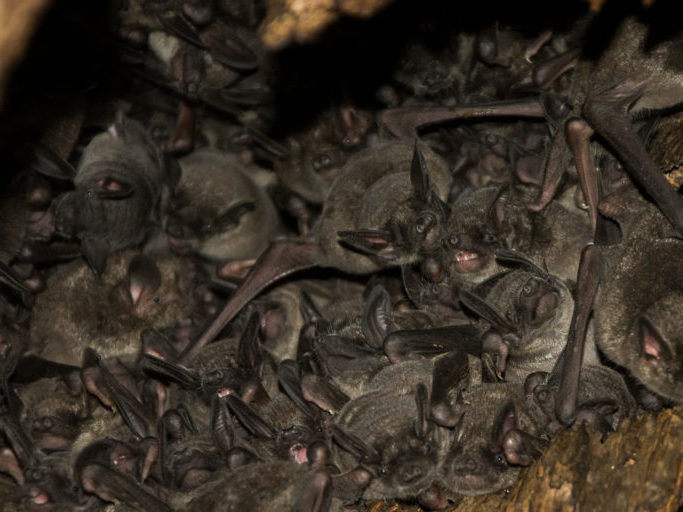
The plant is cryptic and, because it’s hard to see, it’s also hard to survey. It’s thought however, that there are unlikely to be more than a few thousand in existence. Many sites likely are known only to collectors, as the woody growth has commercial value.
It is illegal to collect wood roses from public land, and harvesting this threatened species anywhere is strongly discouraged. It’s conservation status is Threatened – Nationally Vulnerable. As well as the threat of harvesting by collectors, the plant is vulnerable to browsing by possums, rats, pigs and deer, habitat loss, and the rarity of its pollinators and seed dispersers Some plants are thought to be more than 30 years old.
Like the wood rose, short-tailed bats are found mainly in the North Island. They inhabit forests from sea level to the tree line at about 1,100 metres. Within the island, at least 9 distinct populations have been identified, with most being located in the central regions. There are, however, a few isolated South Island populations, including one at Fiordland. Smaller populations have also been identified on Codfish Island and Little Barrier Island.
Pekapeka-tou-poto are nocturnal, spending the day roosting in hollow trees. Many bats roost alone, using small cavities in the wood, but colonies of over a hundred individuals are not uncommon. They usually use natural cavities or crevices, but can also chew out burrows within the wood using their sharp incisor teeth. Such burrows consist of hollowed out chambers connected by narrow tunnels up to several metres in length.
Bats typically spend only a few weeks at any given roosting site, before moving on, although individual roosts may be reused repeatedly over the course of several decades.
The bats emerge from their roosts 20 to 150 minutes after sunset, and forage for much of the night. They spend only around 30% of their foraging time catching insects in the air, typically flying less than 2 metres above the ground. On average, a further 40% of the night is spent feeding from plants. The remaining 30% is spent hunting on the forest floor, a higher proportion than any other species of bat. To assist with ground-hunting, short-tailed bats are able to fold their wings inside a protective sheath formed from their membranes. They then use their folded wings as ‘front limbs’ for scrambling around.
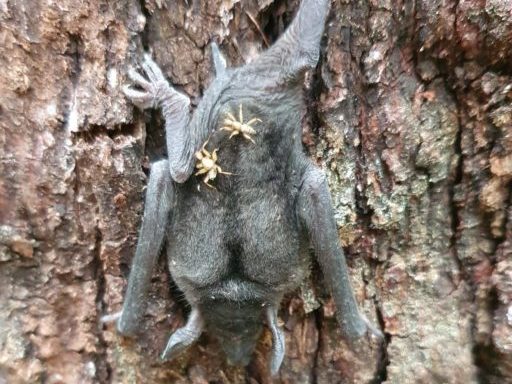
Pekapeka-tou-poto hunt their prey using scent, passive hearing, and echolocation. Their main calls have a wide bandwidth and are multiharmonic, with a peak amplitude of 27 to 28 kHz. They also make shorter pulsed, frequency modulated calls.
Short-tailed bats are able to enter torpor in cold weather and stay in their roosts for up to 10 days at a time before emerging to feed. They may also enter daily torpor when roosting alone, but are capable of remaining active even in subzero temperatures when necessary.
And – as if all that isn’t unusual enough, short-tailed bats (like the kakapo parrot) are lek breeders.
Males occupy individual mating roosts during the breeding season and use repetitive ultrasonic calls to attract females. The males also mark the entrances to their mating roosts with an oily secretion produced in scent glands on the throat; the oil has a musky odour and may help to attract the females. Mating most commonly takes place between February and May.
Although mating takes place in autumn, delayed implantation of the embryo means that young aren’t born until the following summer. Females give birth to a single pup which is hairless, but otherwise well-developed, and weighs just 5 grams. The permanent teeth erupt at three weeks, and the young are fully furred and able to fly by four weeks of age. They leave the maternal roost at six weeks of age and grow rapidly. Within three months they are fully grown.

